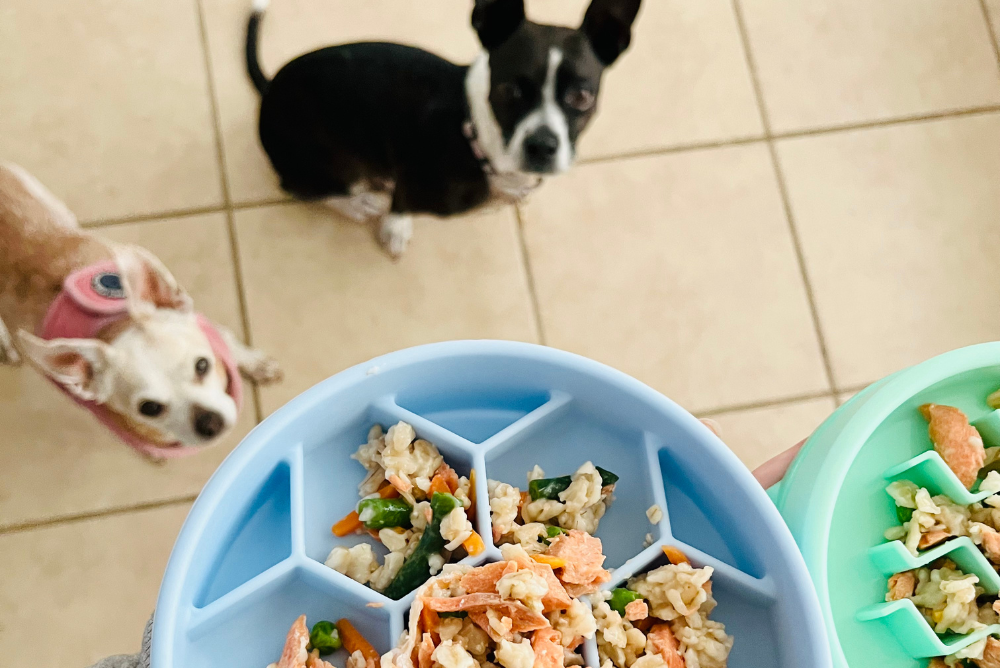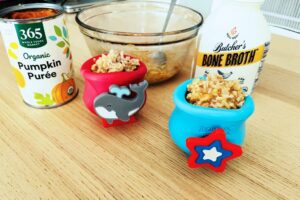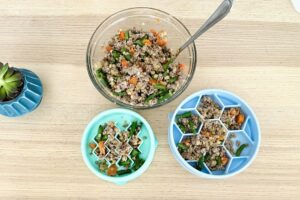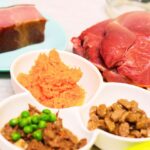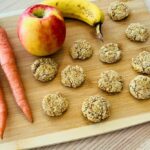If you’ve ever wanted to try making your own homemade dog food recipe, we have an easy and nutritious one for you to try. This homemade salmon dog food recipe is a quick recipe to make and can last up to a week depending on the size of your dog.
It has salmon which is great for skin and coat health plus veggies for even more nutrition. Below the recipe, we talk about the benefits of salmon for your dog. We also offer variations and substitutions for the recipe.
Homemade Salmon Dog Food Recipe
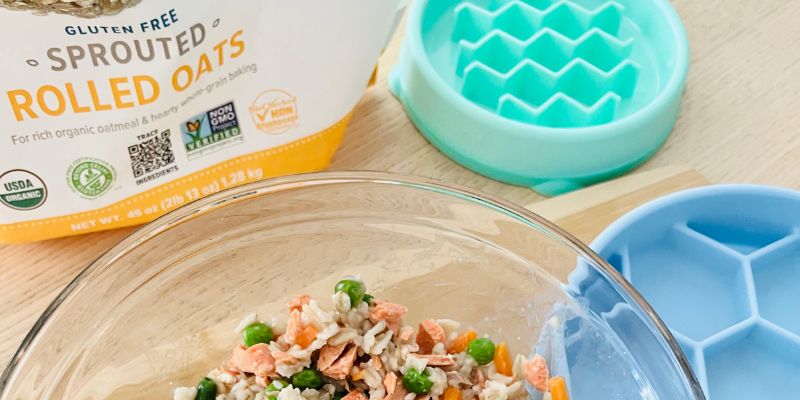
Prep: 10 minutes
Cook Time: 15 minutes
Total Time: 25 minutes
Yields: 3 cups
Servings: 6
Recipe Ingredients:
- 5oz boneless sockeye salmon fillet, poached (see notes)
- 1 cup oats, cooked
- ½ cup green beans, frozen or fresh
- ½ cup peas and carrots, frozen
- 1 tablespoon bone broth (see notes)
Tools needed:
- Measuring cups
- Measuring spoon
- Medium size pot (like a saucepan) with a lid
- Sauté pan with lid
- Small glass container
- Large spoon or spatula
Recipe Instructions
- Poach the salmon in a sauté pan. Once done, set aside in a glass container and use a fork to fluff and break the salmon into pieces. Leave the skin on.
- Cook the oats according to the directions on the package. The oats we used are sprouted and took about 8 minutes to cook. We used 1 cup of sprouted oats and 2 ½ cups of water.
- Once the oats are done, add the frozen vegetables and put a lid on the pot. This will allow the frozen vegetables to soften.
- If you want to use fresh carrots and green beans, you can steam them in a separate pot and add them to the cooked oats.
- Add 1 tablespoon of bone broth to the pot with the oats and veggies. This is optional but adds nutrition.
- Using a spatula or a large spoon, mix the salmon into the pot with the oats and vegetables.
- Once cooled, store in an airtight container in the refrigerator. This food should be consumed within 5 days.
- You can freeze this food in smaller portions, in a Ziplock bag or other airtight container.
Recipe Notes:
- For this homemade salmon dog food recipe, we used frozen sockeye salmon. We made sure it was thoroughly thawed before poaching it. You can also use king salmon or Atlantic salmon. Be sure the salmon you are using is boneless. We poached the salmon in water, but other cooking options include baking, grilling, or roasting the salmon.
- We used a tablespoon of bone broth to add nutrition. Bone broth is great for joint health and has calcium which is an essential nutrient in homemade dog food recipes. Make sure to use a bone broth that has no additives, especially confirm there is no sugar or salt added.
- If your dog tolerates rice, you can also substitute the oats for rice in this recipe. Cook the rice separately and then follow the rest of the recipe. You can add the vegetables to the rice once it’s cooked and then add the salmon.
- Depending on your dog’s weight, you can feed ¼ – ½ cups 2x a day. Check with your vet to get specific serving size recommendations that is based on your dog’s weight, age and other factors.
- If you have a larger dog and want to make a larger batch, you can double or even triple the recipe.
- If you strictly feed your dog a homemade diet, be sure all nutritional needs are being met. You can also add multivitamins to ensure your pup gets all the essential vitamins and minerals.
- Please first check with your veterinarian to ensure the diet you are feeding your dog provides all the nutrients, vitamins, and minerals that your dog needs.
This homemade salmon dog food recipe was really simple to make, and the ingredients will provide your dog with some of the essential vitamins and minerals that they need.
Your dog will love the taste and you can feel good knowing it has a healthy serving of colorful vegetables and high-quality protein.
Whether you are new to making homemade dog food or a seasoned pro, this recipe should be fun for you to try out for your pup.
Benefits of Salmon for Dogs
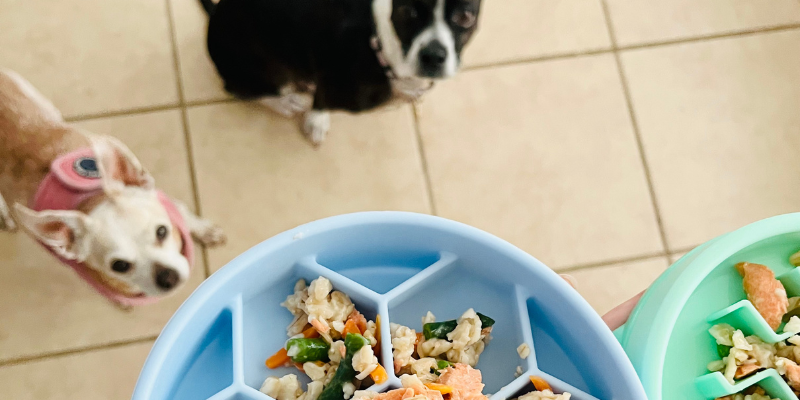
Salmon is a great protein choice for your dog because it contains essential fatty acids and other beneficial nutrients. Since some dogs are allergic to other protein sources like chicken and beef, salmon can be a safe alternative.
Dogs need a high-protein diet and salmon is a high-quality protein choice while also being lower in fat than some of the other protein choices.
Salmon is easy to digest and the nutrients it contains are highly absorbable. High in omega-3 fatty acids, salmon will benefit your dog’s skin and coat health, immune system, and lower inflammation levels.
Salmon also contains these vital vitamins and minerals:
- Vitamins A, D, B-6, and B-12
- Magnesium, Calcium, Potassium, and Phosphorous
Homemade Salmon Dog Food Recipe Variations
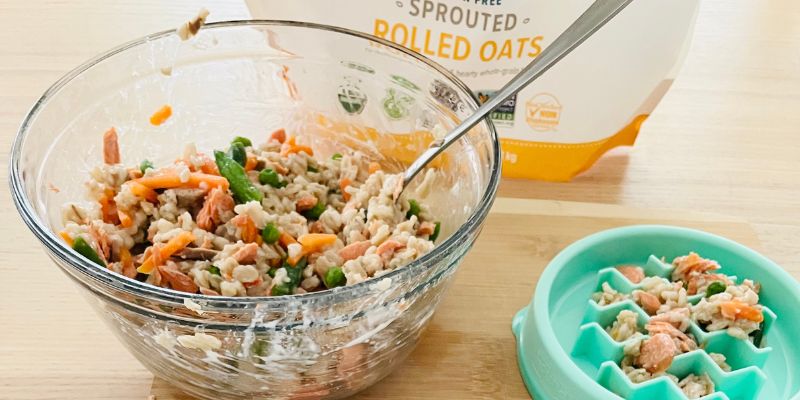
This recipe is versatile because you can change it up if your dog has allergies or if you’ve already made the recipe before and want to alter it for variety.
Here are some ways to mix it up:
- Try other grains instead of oats: rice, quinoa, millet, or barley.
- Leave out the grains for a grain-free recipe: you could use lentils instead.
- Add a chopped, boiled egg for added nutrition.
- Substitute the vegetables for other dog-safe veggies such as:
- Butternut squash
- Yams
- Celery
- Beets
- Rainbow carrots for color
- Broccoli
- Bell peppers
- Zucchini or summer squash
- Pumpkin
In our previous recipe, the chihuahua dog food recipe, we talked about the essential nutrients needed to make a homemade dog food recipe. Here they are again so that you can reference them if you want to change the recipe.
When adding or removing any ingredients, just make sure that the essential nutrients your dog needs are included. You can also use a supplement if needed, choosing the best nutritional supplements for your dog can improve their quality of life!
Essential Nutrients for a Homemade Dog Food Recipe:
- High-quality protein (meat, seafood, dairy, eggs)
- Fat (meat, fish, eggs, or a healthy oil)
- Carbohydrates (grains and/or vegetables)
- Calcium (bone broth, dairy, eggs, or a supplement)
- Essential fatty acids (bone broth, egg yolks, oats)
Salmon is one healthy choice for your pup, but rotating proteins will provide your dog with a healthy variety.
If you haven’t tried salmon on your dog yet, give this recipe a try and see what your pup thinks. Slowly introduce new foods to be sure that your dog tolerates the food and isn’t allergic, and always speak with your veterinarian first before introducing new foods to your dog’s diet.
If your dog is already eating a specific brand of food and you want to start making your own homemade dog food, it is recommended to gradually transition to the new diet. If you make an abrupt change, the chances of a gastrointestinal upset are more likely.
Instead, add some of the new food to your dog’s current food. Slowly add more of the new food and less of the food you are transitioning away from.
We hope you and your dog enjoy trying our different homemade dog food recipes!

